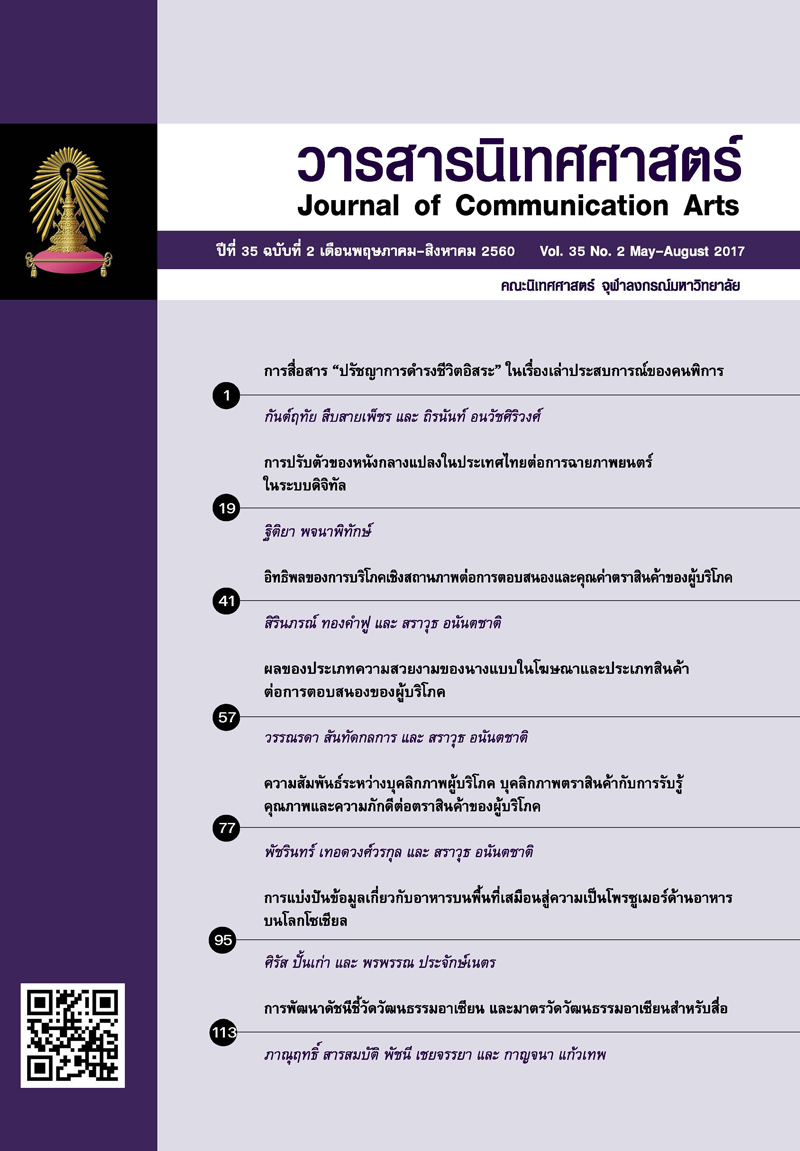Food information sharing on Virtual Space Toward Food Prosumer on Social Network
Main Article Content
Abstract
In this study, the Uses and Gratification Theory was applied to examine consumer’ needs for food information sharing behaviors on Facebook. The respondents of this research included Facebook users, ages between 25 and 65 years old. Online surveys were distributed to 414 respondents (131 male and 283 female) who joined food and cooking Facebook groups which have more than ten thousand members. To be eligible for survey, respondent must share food information on Facebook Fan Page at least one time in three months.
The findings demonstrated that consumers have had a multiple screen behaviors with smartphone as a tool to share information, followed by laptop, computer and tablet. Moreover, they had 5 usage patterns of food information sharing as described below;
1) Promotion and body of knowledge development-- Consumers updated food information for friends and social groups and shared their experiences of food, knowledge and information.
2) Social interaction and social acceptance-- Consumers had conversation with friends and social groups and gained a sense of belonging to social groups.
3) Personal identity-- Consumers use Facebook group for raising awareness toward friends and social groups that they were interested in food and cooking and demonstrating their skills and potentials.
4) Entertainment -- Consumers used Facebook group for fun and enjoyment
5) Marketing category—Privileges, promotions, discounts and special prices offers from brand were consumer motives to use Facebook group.
In addition, the research revealed that uses of food information sharing were statistically related to food information sharing behaviors, and gratifications of food information sharing, at .05 significance levels.
Article Details
References
Adslthailand. (2558). ตีแผ่พฤติกรรมคนไทย ชิม แชะ แชร์ ติด Social อ่านรีวิวร้านอาหารอัพรูปกระจาย(ออนไลน์). เข้าถึงได้จาก http://goo.gl/KN8O3y (สืบค้นข้อมูล :2 มีนาคม 2559)
DAAT. (2558).Infographic แสดงตัวเลขจำนวนผู้ใช้งานโซเชียลมีเดียในประเทศไทย (ออนไลน์). เข้าถึงได้จาก https://goo.gl/EXqmWJ (สืบค้นข้อมูล :23 กุมภาพันธ์ 2559)
Thoth Zocial. (2560). Thoth Zocial เผยสถิติวัยรุ่นไทยใช้ Twitter เพิ่มสูง ย้ำแบรนด์เตรียมใช้ “Chatbot” (ออนไลน์). เข้าถึงได้จาก http://thumbsup.in.th/2017/05/thoth-zocial-statistic-social-media- thai/ (สืบค้นข้อมูล :16 มิถุนายน 2016)
กาญจนา แก้วเทพ. (2547).สื่อสารมวลชน : ทฤษฎีและแนวทางการศึกษา. กรุงเทพฯ:สำนักพิมพ์เลิฟ แอนด์ลิฟ.
ตวงพร เกตุสมบูรณ์. (2555).การใช้อินเทอร์เน็ตกับบทบาทความเป็นแม่บ้าน. วิทยานิพนธ์ปริญญามหาบัณฑิต สาขาวิชาการสื่อสารมวลชน. กรุงเทพฯ:จุฬาลงกรณ์มหาวิทยาลัย
ธีรวุฒิ เอกะกุล. (2543).ระเบียบวิธีวิจัยทางพฤติกรรมศาสตร์และสังคมศาสตร์. อุบลราชธานี:
สถาบันราชภัฎอุบลราชธานี.
มานะ ตรีรยาภิวัฒน์. (2553).นักข่าวกับ Social media(ออนไลน์). เข้าถึงได้จาก https://goo.gl/27pMWx (สืบค้นข้อมูล :2 มีนาคม 2559)
วฒนพงษ์ นิ่มสุวรรณ. (2555). แนวคิดการใช้เครื่องมือสื่อสารในแฟนเพจบนเฟซบุ๊ค และทัศนคติ แรงจูงใจ ที่ส่งผลต่อการตัดสินใจกดปุ่ม "ถูกใจ" ให้เครื่องมือสื่อสารในแฟนเพจบนเฟซบุ๊คของวิสาหกิจขนาดกลางและขนาดย่อม. วิทยานิพนธ์ปริญญามหาบัณฑิต สาขาเทคโนโลยีสารสนเทศ. นครราชสีมา:มหาวิทยาลัยเทคโนโลยีสุรนารี.
วิมลพรรณ อาภาเวท และ วราพันธ์ มุ่งวิชา. (2549).การใช้ประโยชน์และความพึงพอใจในการโฆษณา แบบตอบกลับโดยตรงที่มีผลต่อกระบวนการตัดสินใจซื้อของผู้บริโภคในเขตกรุงเทพมหานคร. มหาวิทยาลัยเทคโนโลยีราชมงคลพระนคร.
วรรณพร กลิ่นบัว. (2553).การสร้างเครือข่ายทางสังคมผ่าน www.facebook.com ของกลุ่มคนวัยทำงาน. วิทยานิพนธ์ปริญญามหาบัณฑิต สาขานิเทศศาสตร์ธุรกิจ. กรุงเทพฯ:มหาวิทยาลัยธุรกิจบัณฑิตย์.
ศิริพร พูพิพัตร. (2553).การใช้ประโยชน์และความพึงพอใจของบุคลากรต่อเว็บไซต์กรมเจ้าท่ากระทรวงคมนาคม. วิทยานิพนธ์ปริญญามหาบัณฑิต สาขาเทคโนโลยีสื่อสารมวลชน. กรุงเทพฯ: มหาวิทยาลัยรามคำแหง.
ศศิมา ชัยวรจินดา. (2555).พฤติกรรมการสื่อสาร การใช้ประโยชน์และความพึงพอใจต่อเว็บไซต์เครือข่าย สังคมเฟซบุ๊ค (Facebook) ของประชาชนในกรุงเทพมหานคร. วิทยานิพนธ์ปริญญามหาบัณฑิต สาขานิเทศศาสตร์และสารสนเทศ. สุพรรณบุรี:มหาวิทยาลัยเกษตรศาสตร์.
ศูนย์วิจัยกสิกรไทย. (2558).อุตสาหกรรมอาหารและเครื่องดื่ม (Foods and Beverages)(ออนไลน์). เข้าถึงได้จาก https://goo.gl/rYbuKZ (สืบค้นข้อมูล :5 มีนาคม 2559)
สุภัทรา ภิญโญกิตติกุล. (2553).“Prosumer on IT-Power Age”. Strategy Marketing, หน้า 46-50.
ภาษาอังกฤษ
American Majority. (2013).facebook A Beginner's Guide(online). from About.com: https://goo.gl/uloRxw (Retrieved : March 2, 2016)
Ashley Dean. (2014).Facebook(online). from About.com:
http://whatis.techtarget.com/definition/Facebook (Retrieved : March 2, 2016)
Basilisco R., & Cha, Kyung Jin. (2015). Uses and Gratifications Motivation for Using Facebook and the Impact of Facebook Usage on Social Capital and Life Satisfaction among Filipino Users. International Journal of Software Engineering and Its Applications, 9(4), 181-194.
Dainton, M., & Zelley, E. D. (2014). Applying communication theory for professional life: A practical introduction, Sage publications.
Fractl. (2016). The Motivations for Sharing on Facebook (online). From About.com: http://goo.gl/XLujYB (Retrieved : August 31, 2016)
Galen C. & Evan F. (2014). “Sharing is Caring”.Journal of Applied Sport Management, Vol.6, No.2, pp. 70-85.
Jason Kincaid. (2010). Facebook Uses Face Recognition To Help Tag Photos (online). from About.com: https://goo.gl/zJ1SAj (Retrieved : March 5, 2016)
Katz, E., Blumler, J. G., & Gurevitch, M. (1973). Uses and gratifications research. The Public Opinion Quarterly, 37(4), 509-523.
Matt Hicks. (2010). Facebook Tips: What’s the Difference between a Facebook Page and Group?(online).From About.com: https://goo.gl/Nx4KxO (Retrieved : March 5, 2016)
McCann truth central. (2012).Truth About Moms(online). from About.com: http://truthcentral.
mccann.com/portfolio/truth-about-moms (Retrieved : February 5, 2016)
McCombs and Becker. (1979). Using Mass Communication Theory, Prentice-Hall, Englewood Cliffs, N. J. 1979: 148.
Nash, Sara M., (2015). Life Beyond Like: Uses & Gratifications of Sharing Business Facebook Page Content. University of Nabraska.
Noor Fathima Warsia. (2014).Asian moms, primary home decision makers, are going mobile first (online). from About.com: http://www.digitalmarket.asia/2014/04/asian- moms-primary-home-decision-makers-are-going-mobile-first (Retrieved : February 5, 2016)
Palmgreen, P., Wenner, L., & Rosengren, K.,. (1985). "Uses and gratifications research: The past ten years."Media gratifications research, pp. 1–37.
Silver, D. (2009). The social networking business plan. Hoboken, N.J: John Wiley and Sons.
Simon Kemp. (2016).Digital in 2016(online). from About.com: http://wearesocial.sg/blog/
2016/01/digital-2016/ (Retrieved : May 5, 2016)
Toffler, A. (1980). The Third Wave. William Morrow& Co., New York.


